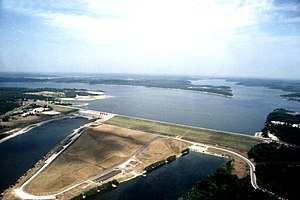Truman Reservoir


The Harry S. Truman Dam and Reservoir (also known as Truman Lake) is located in the state of Missouri, United States. It is a man-made lake and the dam that created and manages the lake's water level. It is located between Clinton and Warsaw, on the Osage River and extends south to Osceola.
History
The U.S. Army Corps of Engineers built and manages the lake and dam. Its primary mission is flood control. Some other missions are power generation, recreation, and wildlife management.
Originally named Kaysinger Bluff Dam and Reservoir in 1954, when construction was authorized, construction began in August of 1964. It was renamed the Harry S. Truman Dam and Reservoir in honor of the former president from Missouri by Congress in 1970. Construction was completed in 1979.
Completing the Truman Project took many years of planning, land acquisition, constructing new bridges and demolishing old ones. Several roads, towns, and cemeteries had to be relocated. The first construction project completed on the project was relocating Route 13 so it would be above maximum pool level.
The creation of the lake forced the closure of the Frisco Railroad's "Highline". Rising water levels severed the railroad tracks near Osceola and Deepwater and railroad officials declined to spend millions of dollars to reroute the lightly-used tracks. The Missouri-Kansas-Texas Railroad, however, did relocate its main line between La Due and Clinton; the project included five miles of new track and a causeway/bridge combination over the lake.
Weaubleau-Osceola structure
The south-west portion of the lake makes up part of the circumference of the Weaubleau-Osceola structure, a 310-340 million year old impact crater.
External links
- The Harry S. Truman Dam and Reservoir site maintained by the Army Corps of Engineers. Note: some material was used for this entry from this public domain source.
- Template:Geolinks-US-cityscale